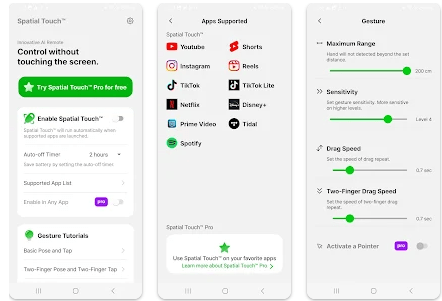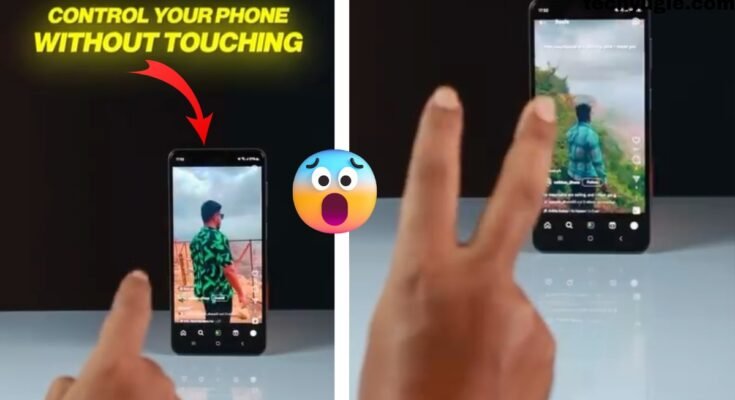In the ever-evolving landscape of mobile technology, the concept of controlling your mobile without touching it has shifted from futuristic fantasy to practical reality. Gesture-based controls, voice commands, facial recognition, motion sensors, and AI-powered tools now allow users to interact with their smartphones seamlessly—without physical contact. This advancement not only enhances user experience but also plays a crucial role in accessibility, hygiene, and convenience. From busy multitaskers to individuals with physical limitations, touchless mobile control offers game-changing functionality across all demographics. This article dives deep into how these systems work, their features, pros and cons, alternatives, and a comprehensive verdict.
What is the Control Your Mobile Without Touching?
“Control your mobile without touching” refers to the use of alternative input methods—such as voice, gestures, and facial movements—to operate a smartphone or tablet. These methods eliminate the need for direct physical interaction with the device. With advancements in AI, computer vision, and sensor technology, modern smartphones now support:

- Voice control via AI assistants (e.g., Google Assistant, Siri)
- Air gestures detected by motion sensors or cameras
- Facial recognition for navigation
- Proximity-based controls
- Eye-tracking and head movements
- Integration with wearables for remote control
These features can be integrated into the operating system, accessed through third-party apps, or built into specialized hardware.
How Control Your Mobile Without Touching
There are multiple technologies and methods that enable hands-free control of your mobile phone:
1. Voice Assistants
- Most modern smartphones come with built-in voice assistants like Google Assistant, Siri, or Bixby.
- Users can wake their phone, send texts, make calls, launch apps, and search the web using voice commands.
2. Gesture Control Apps
- Apps like Air Gesture, Wave Control, or KinScreen allow you to control music, answer calls, or browse photos using hand movements.
3. Facial Recognition and Eye Tracking
- Tools like EVA Facial Mouse track head movements to simulate a cursor.
- Eye-tracking can navigate screens and select items without any physical input.
4. Proximity Sensors
- Some apps use the phone’s proximity sensor to detect hand waves or closeness, triggering certain actions (e.g., unlocking the screen).
5. Wearables and IoT Devices
- Smartwatches and fitness bands can be linked with phones to perform tasks like answering calls, reading messages, or controlling music.
Features of Control Your Mobile Without Touching [Completely Detailing]
- Voice Command Integration
- Support for Google Assistant, Siri, Alexa, etc.
- Execute tasks via simple voice phrases
- Air Gesture Detection
- Swipe, wave, and tap in the air to trigger actions
- Uses infrared or front cameras to detect motion
- Head Movement Navigation
- Uses the front camera to follow your head’s direction for pointer control
- Eye Tracking
- Detects gaze to scroll through content or select options
- Improves accessibility for those with mobility impairments
- Proximity Sensor Triggers
- Detects when the user’s hand is nearby or hovering
- Triggers functions like screen unlock or media playback
- Facial Gesture Recognition
- Smile, blink, or nod to activate commands
- Third-Party Accessibility Tools
- EVA Facial Mouse, Voice Access by Google
- Specialized apps for touchless navigation
- Wearable Connectivity
- Smartwatches and other wearables allow remote control via taps or gestures
- Customizable Triggers
- Assign specific gestures or commands to custom tasks
- Multilingual Voice Support
- Supports commands in various languages
Pros of Control Your Mobile Without Touching [Use Table]
| Pros | Description |
|---|---|
| Hands-Free Operation | Allows users to control phones without physically interacting with them. |
| Increased Accessibility | Helpful for users with disabilities or mobility challenges. |
| Convenience | Operate phones while driving, cooking, or multitasking. |
| Improved Hygiene | Reduces the need to touch your phone, especially useful during illnesses. |
| Enhanced User Experience | Modern and futuristic feel for tech-savvy users. |
| Wearable Integration | Control via smartwatches or IoT devices. |
| Battery-Friendly (in some apps) | Uses minimal resources through low-power sensors. |
| No Additional Hardware Needed | Many features work with existing smartphone sensors. |
Cons of Control Your Mobile Without Touching [Use Table]
| Cons | Description |
|---|---|
| Limited Accuracy | Gesture or voice recognition may not work 100% of the time. |
| Privacy Concerns | Always-on microphones and cameras raise data privacy issues. |
| Not Fully Customizable | Some apps limit control customization. |
| Battery Drain | Background sensors or apps may reduce battery life. |
| Environmental Limitations | Voice commands may not work in noisy environments; gestures may need light. |
| Learning Curve | Some features may take time to understand and operate efficiently. |
| Hardware Dependency | Not all devices support advanced motion or eye-tracking sensors. |
Control Your Mobile Without Touching Alternatives [Use Table]
| Tool / App Name | Method of Control | Platform | Free/Paid | Key Feature |
|---|---|---|---|---|
| Google Voice Access | Voice Commands | Android | Free | Full phone control via speech |
| EVA Facial Mouse | Facial Gesture | Android | Free | Cursor control using head movement |
| Bixby / Siri | Voice AI Assistant | Android / iOS | Free | Native voice control integration |
| Wave Control | Air Gesture | Android | Paid/Free | Control music, calls by waving hands |
| KinScreen | Proximity Sensor | Android | Paid | Turn screen on/off with motion |
| iOS AssistiveTouch | On-Screen Gestures | iOS | Free | Replace hardware buttons with virtual |
| TapTap | Tap on Back (Android only) | Android | Free | Trigger actions by tapping phone rear |
Conclusion and Verdict Control Your Mobile Without Touching
Controlling your mobile without touching it is no longer a science fiction fantasy—it’s a functional, practical reality. With a wide range of technologies such as voice control, facial recognition, gesture detection, and proximity sensing, smartphones are now more intelligent and accessible than ever before. These features empower users to interact more efficiently with their devices, especially when multitasking or in situations where touching a device is inconvenient or impossible.
While there are certain limitations—like accuracy and environmental factors—the benefits far outweigh the drawbacks, particularly for users seeking hands-free convenience, improved hygiene, or accessibility support.
Whether you’re a tech enthusiast, someone with a disability, or just looking to simplify your digital life, hands-free mobile control offers a new realm of possibilities.
Control Your Mobile Without Touching
As technology continues to evolve, the future of touchless interaction looks even more promising. Emerging developments like neural input (mind control), wearable AR interfaces, and improved AI models are expected to further enhance the way we interact with our mobile devices. For now, exploring voice assistants, gesture apps, and accessibility tools is a great start toward a more seamless and futuristic mobile experience—without lifting a finger.



